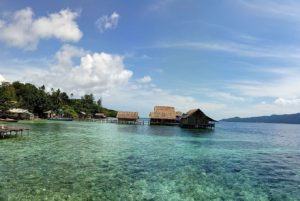
Raja Ampat is a group of islands located in the west tip off Bird’s Head Peninsula, West Papua, Indonesia. This scenic place, comprising 1,500 islands and 100 villages, has been dubbed as ‘The Last Paradise’ and ‘Underwater Paradise’ by many people. This labels are not without a reason. According to the Nature Conservancy and Conservation International, Raja Ampat has 75% of the coral reef and underwater biota found around the world; 1,508 species of fish, 537 species of coral, and 700 types of mollusks. A report from Raja Ampat’s Tourist Information Center shows that every year since 2007, Raja Ampat has had an increase of visitors ranging 1,000 to 2,000 each year. In 2016, for example, there were around 20,000 visitors from around the world spending time in the archipelago. Unfortunately, some of the tourists come to Raja Ampat only for diving and snorkeling. They join a cruise and stay in a boat. For me personally, staying in a boat without experiencing enough land life is a miss of full Raja Ampat experience. Despite its beautiful marine life, Raja Ampat has so much more to offer beyond diving and snorkeling.
Teaching English to local children is one of the greatest and most meaningful activities in Raja Ampat. It is the best way to connect with local people and learn about their culture. In Sawinggrai village on Gam Island, for example, there is a volunteer project known as Sawinggrai English Effort. Its purpose is to help local villagers learn English from visitors. Here visitors can have a proper English class at the local school or in the learning center building provided by the village. If teaching sounds too much, visitors can also do a ‘walking program’, simply play or swim with the students while learning words like sand, shells, stones, and fish. Whatever the plan is, the local learners will always be excited to spend time with foreigners. Best of all, there is a local coordinator who will help the visitors recruit students and organize your class. Those who are interested in the program can visit www.seerajaampat.com for further information.
Another recreation is to take a nature walk and explore the wildlife. Raja Ampat is not only rich in marine life, it also has diverse flora and fauna. The cutest animal in Raja Ampat is probably a Cuscus. These marsupials are actually nocturnal, but visitors sometimes can see them during the day on the top of coconut trees. Other common animals found in Raja Ampat include monitor lizards, coconut crabs, bats, sugar gliders, and a lot of birds. Some areas in Raja Ampat also have orchids growing wildly or planted by local people. Up the hill in Sawinggrai on Gam Island, there is an orchid garden where the villagers planted many kinds of orchids from some islands in Raja Ampat. Besides Orchids, there are many types of plants as well. To take a walk, visitors can ask their homestay owners or villagers to show them the local garden and forests.
Birdwatching is another exciting activity to do, considering the diversity of Raja Ampat’s bird life. A trip to Raja Ampat will not be complete without doing a single birdwatching trip. According to the Avibase – Bird Checklists of the World, Raja Ampat is home to 362 species of birds. The list includes Wilson’s and Red Birds of Paradise, which are among the most beautiful birds on the planet. Both birds of paradise can be found on Waigio Island, the biggest island in Raja Ampat. The red one can be easily found on Gam Island. To do birdwatching, visitors can hire local tour guides, or they can go by themselves.
Many visitors come to Raja Ampat only for diving, snorkeling, and enjoying the marine life. While nothing is wrong with that, it is a shame to miss other wonderful things that Raja Ampat provides. Other activities like birdwatching, taking a nature walk, and teaching local children English are worth spending time on.
This article has been published in the Jakarta Post. Please click this link to see the complete article.
